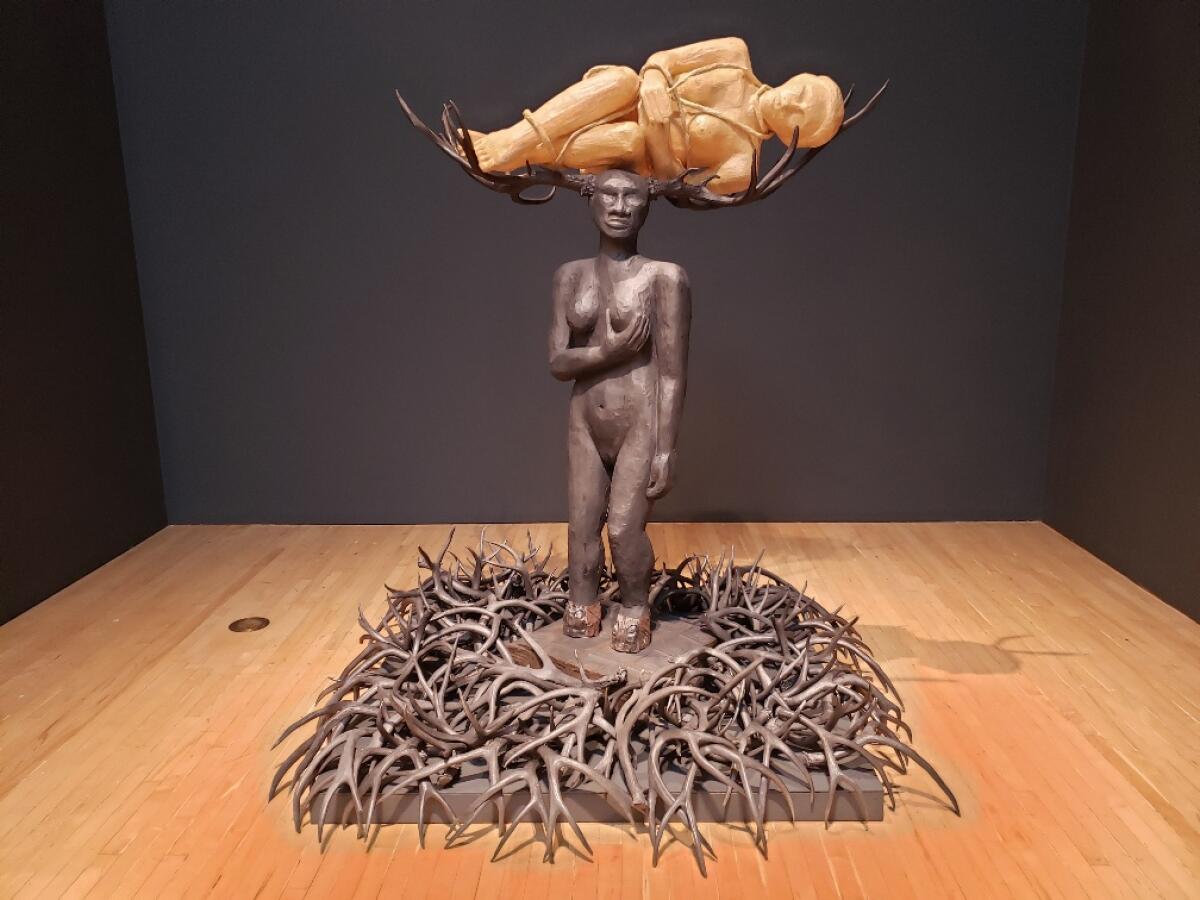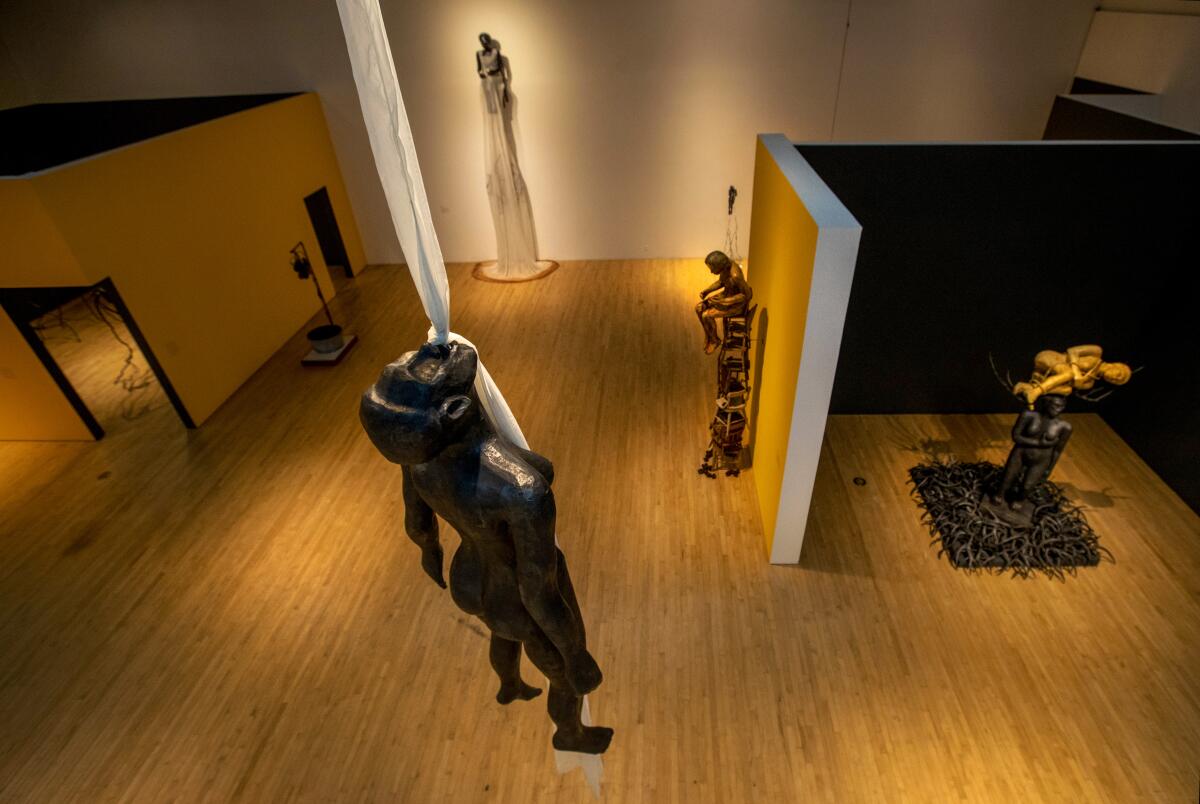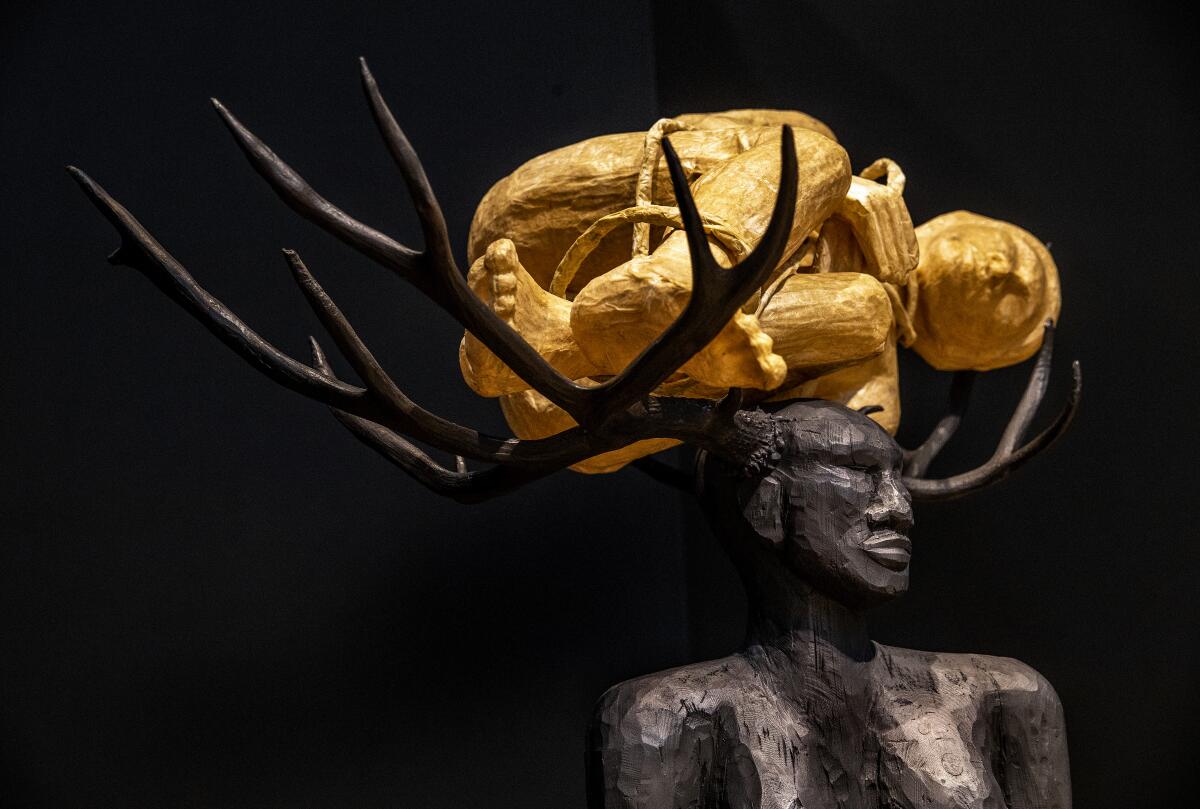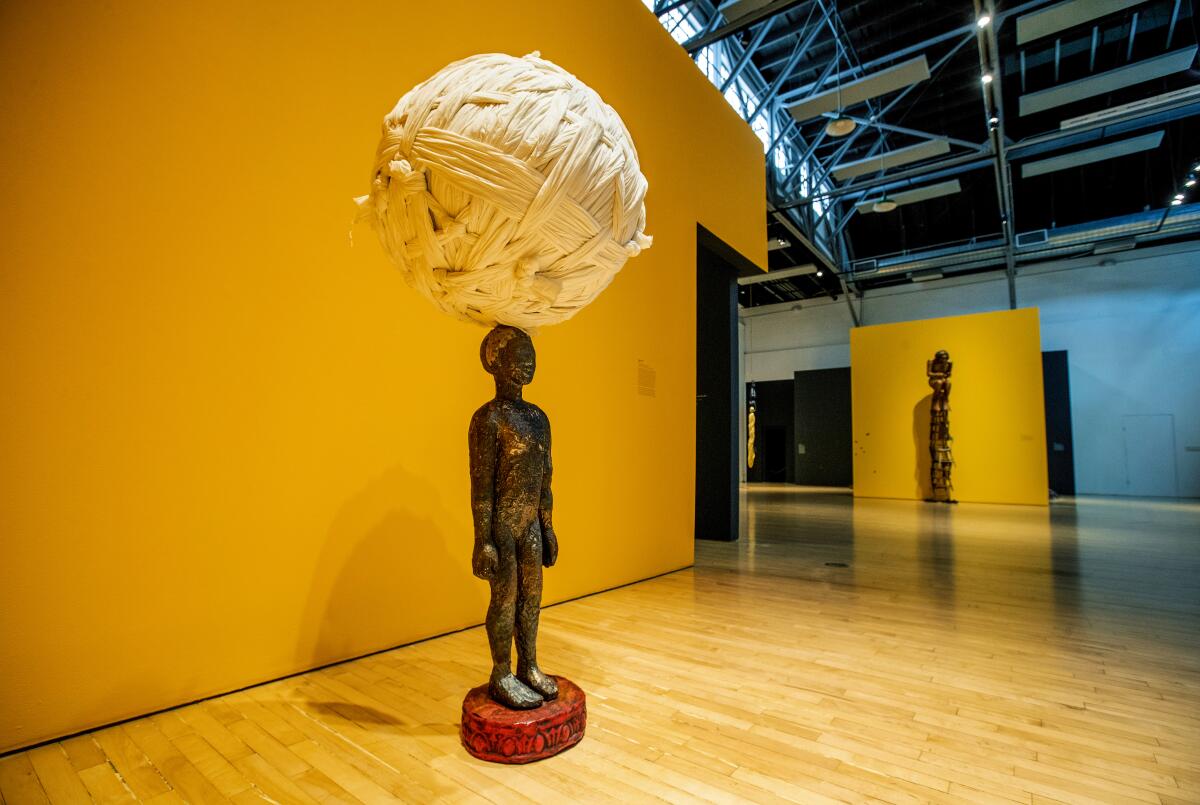Review: Alison Saar’s poetic chronicles of Black womanhood

- Share via
Alison Saar’s sculptures of Black women are like sentinels. Standing or enthroned, their job is to keep watch.
And in some uncommonly disconcerting instances, to be on the lookout while suspended from the ceiling, rather than rising upright from the floor, languishing on a pedestal or seated in a simple chair.
Two dozen of these extraordinary sculptures are on view in “Alison Saar: Of Aether and Earthe,” an enthralling two-part survey being shared by the Armory Center for the Arts in Pasadena and the Benton Museum of Art at Pomona College in Claremont. The artist has been an eloquent, poetic chronicler of Black womanhood for more than 30 years. Together, the exhibitions confirm Saar’s stature as among the finest American sculptors working today.
“Pearly” is emblematic. The life-size nude figure, dangling from the ceiling, is fashioned from paper and carved foam, all painted with black acrylic and rich, light-reflective graphite. Her head is tossed back, her feet and right arm hang loose.
Her left arm is slightly different. It ends at a hand definitively turned out, its palm facing forward. The gesture is subtle but essential. It radiates Pearly’s careful exertion in performing a conscious balancing act.
And rightly so: She is suspended on a length of translucent white drapery, tied at the top to a rafter high overhead and clenched in her teeth. The allusion to a lynching is inescapable. Yet, as she’s hoisted on a silky scarf rather than a rope, so is the insinuation of an aerial acrobat, a powerful woman who is in complete control.
“Pearly” is at once casualty and victor. A vulnerable woman at the mercy of forces larger than herself, she’s also an invincible powerhouse in command of her bodily presence. Saar simultaneously conveys contradictory states of being, skillfully embodying the truth of human complexity.

The sculpture is based on an actual person. Olga Brown, professionally known as Miss La La, was a Prussian-born 19th century circus star.
La La inspired Edgar Degas to paint her suspended by her teeth high above the floor of the Cirque Fernando, a Paris pleasure spot at the edge of Montmartre frequented by artists. (A pastel study for the painting is in the collection of the Getty Museum.) The Degas views the high-flying Black performer from below, her face mostly obscured, and arms flung out widely.
No audience is in sight. She’s a visual spectacle fulfilling his curiosity. Saar reclaims the strength and vulnerability embodied in the acrobat’s act, which attracted Degas, but she recasts it from the sharp, feminist perspective of a Black American woman.
The sculpture, metaphorically midway between heaven and earth, evokes the ancient “Aether and Earthe” of the show’s title, which inserts Saar’s work into an age-old legacy. Standing beneath “Pearly” and looking up at her ascension, you see something like a Classical figure of virtue or nobility floating aloft in a Tiepolo ceiling fresco — albeit humanized rather than idealized.
Most of Saar’s sculptures are carved from wood, many then covered in salvaged ceiling tin. The tin’s raised pattern, weathered and abraded, yields the look of ancient African body scarification practiced as ritual ornamentation — here given an urban, Western edge.
Review: Alison Saar traces diasporas in the exceptional ‘Silt, Soot and Smut’ at L.A. Louver Gallery
When the Great Mississippi Flood displaced hundreds of thousands of African Americans in 1927, many chose to keep on going.
The proliferation of hammered nails echoes Nkisi N’Kondi sculptures, the great Central African power figures studded with scores of them. Sometimes Saar uses the nails to crown a sculpture’s head, as if with hair.
“Shorn” juxtaposes a stubbly pate of them with long, tangled tresses of wire. (The material recalls the frayed and unraveling wire rope in work by dancer-sculptor Maren Hassinger.) They cascade from the figure’s right hand — she holds a sharp glass shard for cutting in the other — finally wrapping like a graphic whirlwind around her feet. Nkisi N’Kondi meets Venus meets Rapunzel.
In “Conked,” the hair is bundled wire that circulates over the top of a Brancusi-like sleeping head, tucks in through the mouth and flows out the severed neck. The title’s reference to chemically straightened hair takes the form of sculptural speech: Beauty’s source in nature is cut off, then recovered as art.
The sculpture is typical of the bracing degree of complexity Saar manages through simplicity of formal means. She interweaves contemporary concerns into a host of sculptural traditions.
Among the most poignantly beautiful is “Inheritance.” A waist-high figure of a young girl is carrying an enormous sphere of white sheets, wrapped and twisted and balanced almost majestically on her head.
Those white sheets are clean laundry, expressing a once-and-future life of labor. They are also bundled remnants of KKK terror, poised like a thought balloon over her head. Saar fashions the girl as a child-Atlas, charged with carrying the weight of the world.
The figure fuses Old Kingdom Egyptian, early Greek Classical and sub-Saharan African forms. Saar’s cross-cultural design is a history-laden technique, not unlike Martin Puryear’s huge “That Profile” on the tram-arrival plaza of the Getty Center — a four-story sculpture that overlays the regal form of a Yoruba head onto a convention of Italian Renaissance portraiture framed against a landscape backdrop. In art, antiquity lives on in the present.
Saar’s layering of artistic generations encompasses human ones. For an ensemble provocatively titled “Rouse,” a sturdy woman with hooves for feet cups her full breast, a bound child nestled in protective antlers spread wide across her head. A deer, ancient totem of regeneration revived by modern artists like Frida Kahlo, merges with the body of a woman. The offspring, made from fiberglass, is like a chrysalis. A mythic awakening is underway.

Alison Saar, “Rouse” (detail), 2012, wood, bronze, fiberglass, and antler sheds
Curators Rebecca McGrew (at Pomona) and Irene Georgia Tsatsos (at Pasadena) have assembled 24 sculptures and installations, most from the past 20 years (Saar is 65), along with five graphics and mixed-media works. Among the latter is an exceptional painting.
“High Cotton,” 7 feet high and 8½ feet wide, is painted in acrylic on what is effectively a pieced quilt made from denim and seed sacks patched together. The entire field is dyed indigo blue.
Lined up across the picture is a frieze of five young Black girls, their hair tied up with tiny bows. The pigtails seem to sprout the cotton bolls rising from plants behind them. Their dresses are another shade of blue, as are the almond-shaped slits of their blank, glowing eyes.
The girls carry metal and wood farming tools — hatchet, pitchfork, hoe, machete and scythe — displaying the same color scheme as the brown-skinned kids. The farm implements do double duty as weapons.
The staring kids are like “Children of the Damned,” naturally endowed with extraordinary powers and prepared to fight for their lives. The cadenced distribution of cotton bolls across the picture just over their heads evokes musical notes written on a staff. “High Cotton” visually sings the blues.
The painting is a study for a five-part sculpture, “Topsy Turvy,” which muses on the enslaved child in “Uncle Tom’s Cabin,” Harriet Beecher Stowe’s famous anti-slavery novel. Unfortunately, that large ensemble is not in the exhibition. (They were shown together at L.A. Louver Gallery in 2018; in the sculpture, Topsy’s lips are painted blue.) The Armory and the Benton deserve high praise for choosing to organize the Saar show, but its division into two venues and the limited space at each are workable but not ideal to survey such a rich and abundant career.
The exhibition’s subtitle, “Of Aether and Earthe,” resonates with spirit and body. As critic Leah Ollman once put it, “the personal, political and poetic converge” in Saar’s sculpture. Given the extraordinary agency of Black women in American life, it’s hard to think of any recent art more salient right now.

Alison Saar
Armory Center for the Arts, 145 N. Raymond Ave, Pasadena, (626) 792-5101, through Dec. 12. Closed Mondays through Thursdays. armoryarts.org
Benton Museum of Art, 120 W. Bonita Ave., Claremont, (909) 621-8283, through Dec. 19. Closed Sundays and Mondays pomona.edu/museum
More to Read
The biggest entertainment stories
Get our big stories about Hollywood, film, television, music, arts, culture and more right in your inbox as soon as they publish.
You may occasionally receive promotional content from the Los Angeles Times.











